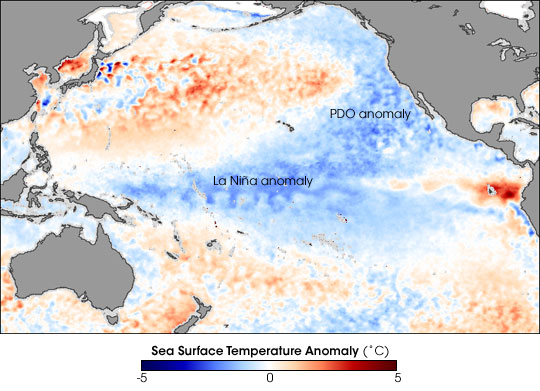Cool Pacific Ocean Slowed Global Warming

The Pacific Ocean has been a planetary air conditioner for the past two decades, but the relief may soon end, a new study finds.
The Pacific and Atlantic oceans undergo decades-long natural oscillations that alter their sea surface temperatures. These natural cycles flip-flop between cooler and warmer phases. Over the past 130 years, the tempo of global warming has revved up or slowed down in tune with changing ocean temperatures, researchers reported today (Feb. 26) in the journal Science.
For instance, cool temperatures in the northern Atlantic Ocean slowed global warming in the early 20th century, the study found. But since the 1950s, aerosol pollution and greenhouse gases have overwhelmed the natural signal, the researchers said.
The Pacific Ocean wielded its mighty influence starting in 1998, when it interrupted the rapid climb of global temperatures, the study reported.
"The Pacific Ocean appears to be driving the slowdown in warming over the past 15 years," said lead study author Byron Steinman, a climate scientist at the University of Minnesota-Duluth.
The period since 1998 is often called a global warming pause or global warming hiatus, because the planet's thermometer slowed its steady climb. However, it's more accurate to call the intervening years a global warming slowdown. Temperatures never stopped rising, and the 10 hottest years ever recorded have all happened since 1998. And though global surface temperatures have plateaued, the oceans are still warming — studies have found the "missing" heat is going into deeper layers of the sea. [6 Unexpected Effects of Climate Change]
The slowdown coincides with a remarkable trend toward cooler temperatures across much of the Pacific Ocean, the researchers said. "This is the largest natural excursion we see in the record," said study co-author Michael Mann, a climate scientist at Pennsylvania State University.
Sign up for the Live Science daily newsletter now
Get the world’s most fascinating discoveries delivered straight to your inbox.
The natural oscillations underlying the 17-year slowdown include the Pacific Multidecadal Oscillation (PMO) and the shorter El Niño cycle, the researchers said. The newly coined PMO is a longer version of the more familiar Pacific Decadal Oscillation, the researchers said. The PMO flips every 50 to 70 years, while the Pacific Decadal Oscillation is on a 16- to 20-year cycle, according to the study.
The El Niño cycle tends to produce more El Niños (warm) or La Niñas (cool) on a 20-year rhythm. During an El Niño year, the ocean releases heat, triggering a spike in global surface temperatures. Since 1998, when the slowdown started, there have been more La Niña years than El Niño years.
Moving on up
Historical patterns suggest the cycles will flip back toward warm in the next few decades, the study predicts. Instead of dragging down global temperatures, the Pacific will turbo-boost global warming.
"We are in a turning point right now, and the slowdown will presumably reverse in the decades ahead," Mann said. "When we do, we may see warming even faster than what the models are predicting."
However, the temperature changes triggered by the oceans only account for about 0.03 degrees Fahrenheit (0.15 degrees Celsius) of the ups and downs in global temperatures, the researchers reported. The warming due to human activities, such as greenhouse gas emissions, swamps this natural signal, said Michael England, a professor at the University of New South Wales in Australia who was not involved in the study. The planet's thermometer has steadily climbed by 1.4 F (0.8 C) since 1880. Global temperatures may rise another 4 to 7 F (2 to 4 C) by 2100.
"This study does support work that points to the Pacific as a primary driver of decadal variability," England said.
Steinman, Mann and co-author Sonya Miller, also of Penn State, tested the influence of decadal oscillations on global temperatures with state-of-the-art climate models. The team drew on 150 computer models from research centers around the world, and compared their results to historical observations since 1854. The simulations were averaged together to remove the influence of external factors such as pollution, volcanic eruptions and the sun's 11-year cycle.
The new findings highlight potential shortcomings in current climate models, which have not captured the natural variations that contributed to the global warming slowdown, said Ryan Sriver, an atmospheric scientist at the University of Illinois at Urbana-Champaign who was not involved in the study.
Follow Becky Oskin @beckyoskin. Follow Live Science @livescience, Facebook & Google+. Originally published on Live Science.











